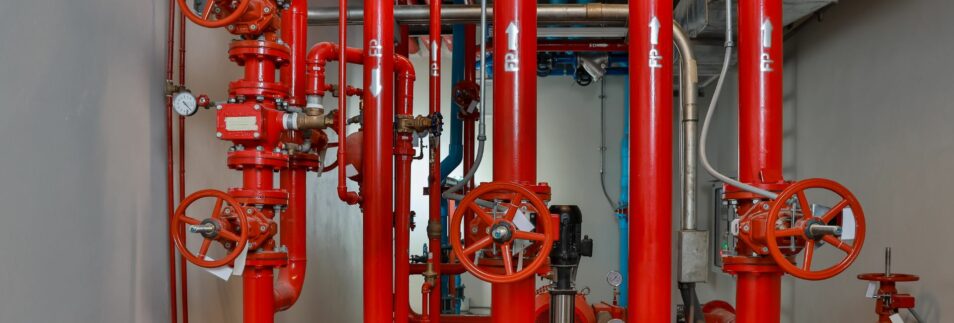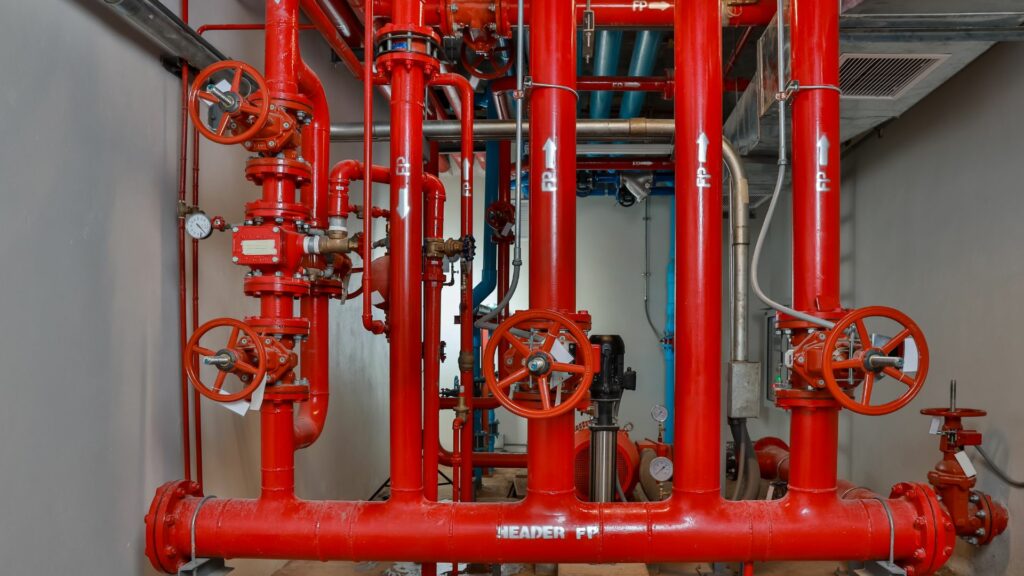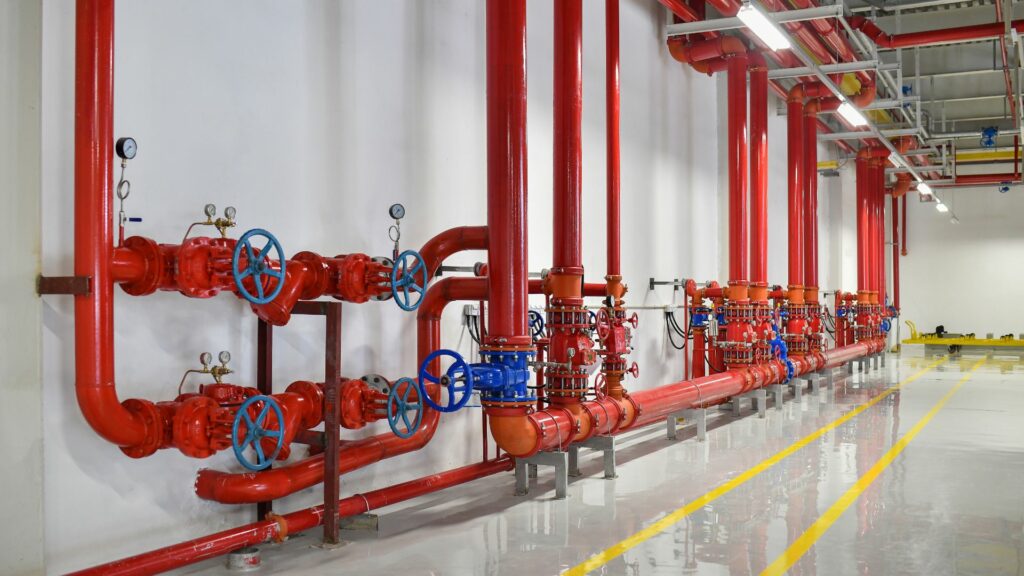Operational Benefits Of Dry Sprinkler Systems

Facing issues with your fire protection system in colder climates? Dry sprinkler systems offer a solution. In places where the thermometer dips low, they keep water from turning to ice in pipes.
This blog post will guide you through the benefits of using these systems for your commercial property or facility. Stay safe and read on!
Key Takeaways
- Dry sprinkler systems use pressurized air or nitrogen to prevent water from freezing in pipes, making them perfect for cold climates where wet pipe systems would fail.
- These systems reduce the risk of water damage by releasing water only when needed during a fire, which can lead to lower insurance costs and less need for costly repairs.
- They respond quickly to fires because they don’t have standing water in the pipes that needs to be pushed out before firefighting water can flow.
- Installation and maintenance costs tend to be lower with dry sprinkler systems since there’s no need for antifreeze solutions or heating elements to prevent freezing, leading to long-term savings.
Understanding Dry Sprinkler Systems

Dry sprinkler systems protect buildings from fires without water in the pipes until needed. Unlike their wet-pipe counterparts, these systems use pressurized air or nitrogen to keep water at bay, ensuring sprinkler heads activate only during a fire.
Definition and purpose
Dry sprinkler systems fill their pipes with pressurized air instead of water. This setup helps protect buildings against fires in places where the cold might freeze a wet pipe system.
A fire makes the air pressure drop, which then opens a valve to let water spray from the sprinkler heads. This clever design is perfect for areas prone to freezing temperatures, like freezers or unheated warehouses.
These systems aim to prevent water damage and ensure that fire suppression works even in the coldest conditions. For commercial property managers and facility managers in Maryland, understanding how these automatic sprinklers function can save money on repairs and keep properties safe from fire hazards year-round.
Next up: Let’s look at what sets dry sprinkler systems apart from their wet counterparts.
Differences from wet sprinkler systems
To understand the operational benefits of dry sprinkler systems, it’s essential to grasp how they differ from wet sprinkler systems.
| Feature | Dry Sprinkler Systems | Wet Sprinkler Systems |
|---|---|---|
| Contents | Pressurized air or nitrogen | Water |
| Use Environment | Suitable for freezing temperatures | Not suitable for areas that freeze |
| Risk of Accidental Discharge | Lower risk | Higher risk |
| Risk of Water Damage | Reduced risk | Higher risk |
| Maintenance Needs | Regular checks needed for air pressure and valve integrity | Regular checks needed for water leaks and pipe integrity |
Dry systems use pressurized gas to keep water out until a fire triggers the system. This setup is ideal for cold places where water in pipes might freeze. Wet systems, always filled with water, can’t be used in these environments. Dry systems also cut down on the chance of water harm since they only fill with water when necessary. Despite these advantages, they need regular upkeep to make sure the pressurized air or nitrogen and valves are working right. This table breaks down the key differences, helping commercial property managers and facility managers in Maryland decide which system fits their needs best.
How they work
Dry sprinkler systems rely on pressurized air or nitrogen instead of water sitting in the pipes. This setup keeps water at bay until a fire triggers the system. Imagine a network of pipes, like veins, filled not with water but with air under pressure.
This method ensures that no water is inside the pipes to freeze and damage them during cold weather.
Once a fire activates one or more automatic sprinklers, this pressure drop signals the control valve to open up. Water rushes into the pipe system, heading straight for the activated sprinklers to douse the fire.
It’s a precise operation: detect fire, lose air pressure, release water. This quick response helps save properties and lives by getting water exactly where it’s needed without delay.
Advantages of Dry Sprinkler Systems

Dry sprinkler systems bring big wins to the table for properties at risk of freezing or where water damage from fire protection systems is a concern. They use air and special substances instead of water in their pipes, waiting to spring into action only when needed, making them smart options for keeping buildings safe without unnecessary harm.
Protection in freezing environments
In cold areas, buildings face the danger of water in fire sprinklers freezing. This can harm the system and lead to costly repairs. Dry sprinkler systems offer a smart solution by using pressurized air or nitrogen instead of water in the pipes.
This method keeps water out until a blaze needs extinguishing, protecting against ice damage.
These systems shine in places with low temperatures because they reduce downtime and extend their useful life. For commercial property managers and facility operators in Maryland, this means saving money over time.
The design also ensures that buildings stay safe from fires without the worry of freezing issues common with traditional wet-pipe systems.
Reduced water damage
Moving from the capability of maintaining function in freezing conditions, dry fire sprinkler systems also significantly reduce water damage. This system holds pressurized air or nitrogen until a fire triggers it.
Once activated, it releases only the necessary amount of water. This precision minimizes mold growth and safeguards property and inventory from extensive water harm.
Businesses benefit greatly as this reduced risk of significant water damage can lead to lower insurance payments. With less potential for costly repairs and mold remediation, commercial property managers and facility managers find dry sprinkler setups an efficient choice for protecting their buildings while managing expenses more effectively.
Faster response time
After talking about how these systems cut down on water damage, it’s key to note their speedy reaction. Dry sprinkler setups react almost at once when a fire starts. This quick action can drastically trim down the extent of fire harm.
These systems are primed and ready, filled with pressurized air or nitrogen instead of water. So, the moment a fire is detected, they spring into action without delay.
This rapid response is especially crucial in environments where every second counts towards preventing major losses. By holding back flames swiftly, dry sprinkler systems help ensure safety for both people and property alike.
They stand guard over your premises, offering peace of mind that if a blaze does ignite, the system will tackle it fast – potentially saving lives and avoiding serious damage to buildings or contents within.
Lower installation and maintenance costs
Dry sprinkler systems come with a big advantage: they are cheaper to install than traditional wet-pipe systems. This is great news for commercial property managers in Maryland who need to manage budgets carefully.
The system’s design allows it to use air pressure rather than water in the pipes, which means there’s no need for antifreeze solutions or constant heating to prevent freezing. This cuts down on initial setup costs significantly.
Maintenance of these systems also tends to cost less over time. Since there’s no standing water in the pipes, the risk of corrosion and pitting that could lead to leaks is much lower.
Fewer leaks mean less water damage and fewer expensive repairs. Plus, without the need for glycol or glycerin-based antifreeze solutions, ongoing upkeep becomes simpler and more cost-effective, ensuring that automatic fire protection remains both reliable and economical.
Potential Disadvantages
Dry sprinkler systems face some challenges, too. They can rust faster than wet pipe systems because air and moisture mix inside the pipes. This means they often need more check-ups to stay in good shape.
Plus, while they’re great at responding quickly, making sure they work right demands careful attention to their air flow and water supply setups.
Increased risk of corrosion
Dry sprinkler systems do not have water sitting in the pipes. This creates a space where oxygen can gather, speeding up corrosion inside the piping. Corrosion causes the steel or iron parts to weaken over time.
This weakening can lead to leaks and malfunctions in the automatic sprinkler system. These issues might make the system less reliable during a fire.
High humidity areas or places with chemical exposure add to this risk, making corrosion even worse. Regular checks are vital to spot early signs of corrosion and fix them before they cause big problems.
Moving on, let’s discuss performance considerations for these systems.
Performance considerations
Dry systems might act slower during a fire because they need time to fill with water. This could mean the difference between minor damage and a major disaster. They use air pressure to keep pipes dry until needed, making them ideal for places where temperatures drop below freezing.
Yet, this setup requires close attention to ensure everything works right in an emergency.
These systems also demand regular checks for leaks and proper air pressure levels. Such maintenance is key to keeping them ready at all times. Facility managers must balance these performance factors with the benefits of using dry sprinkler setups in specific environments.
Now, let’s move on to discussing the care these systems need regularly.
Regular maintenance requirements
Dry sprinkler systems need regular check-ups to work well and safely. These check-ups include looking at, testing, and taking care of valves, air pumping machines, and pipes. A good fire protection company should do this work often.
They make sure everything functions as it should. This keeps the system ready to fight fires fast and protects both people and buildings.
To avoid problems like rust in the system or parts not working right, these maintenance tasks are key. Pipes must stay clear so water can flow quickly during a fire. Checking air dryers also matters because they keep moisture out of the system, preventing freeze-ups in cold areas.
This care helps maintain the benefits of dry sprinkler setups – like less water damage and better security against fires in places where temperatures drop below freezing.
Conclusion and Final Thoughts
Dry systems stand strong against freezing temperatures, keeping properties safe without the need for constant heating. These setups save on water damage repairs since they use pressurized air or nitrogen.
Their quick action during fires cuts down response times significantly. Because of their design, these systems also bring down installation and upkeep costs. Facilities covering vast spaces benefit greatly from such efficient fire safety solutions.
Embracing dry sprinkler setups can transform fire safety practices, making them leaner and more adaptable to challenging environments.
FAQs
1. What makes dry sprinkler systems different from wet-pipe sprinkler systems?
Dry sprinkler systems use air or nitrogen in the pipes instead of water, unlike wet-pipe sprinkler systems that always have water in them. This difference helps protect against pipe freezing and water damage.
2. How do dry sprinkler systems work?
When a fire is detected, the air pressure in the dry system drops, opening a valve that lets water flow through. The system then uses this water to extinguish or control the fire.
3. Are dry sprinkler systems good for all buildings?
Dry sprinkler systems are especially beneficial for buildings where temperatures can fall below freezing, like unheated warehouses or refrigerated areas, because they prevent pipes from bursting due to frozen water.
4. Can dry sprinklers handle fires as well as wet-pipe systems?
Yes! Dry sprinkler systems are designed to provide rapid response to fires with automatic activation and can be filled with pressurized air or even dry chemicals to suppress combustibility effectively before the water is released.
Jason Martin is an expert in commercial alarm and fire protection services, with more than 15 years of experience. He works at Castle Sprinkler and Alarm, a leading company in the sector.
